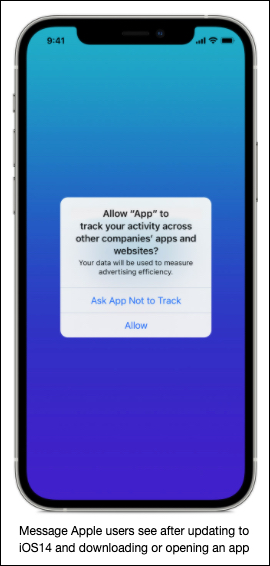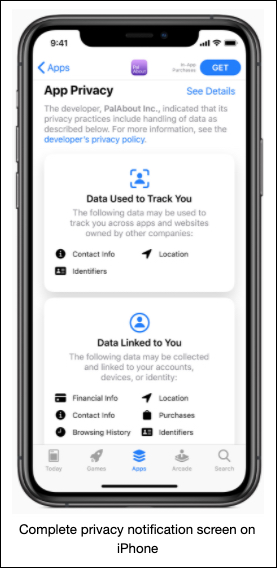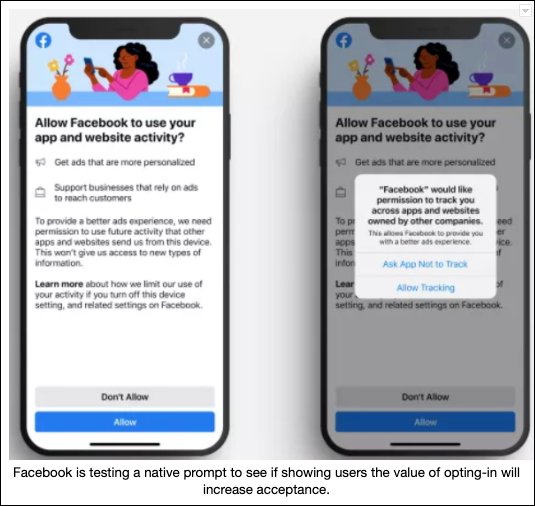
The moment has arrived. Apple is the first major platform to go into enforcement mode of privacy notification rules. Apple now requires that app users must see a pop-up that asks them if they want to allow an app to track them or not. This is a landmark time in 3rd-party tracking technology with 6 out of 10 people in the United States being Apple users running iOS.
First, what is it?
Apple’s latest update, iOS14.5, turned on the functionality and any app available on the Apple platform must comply and offer users the opportunity to opt-in any or all tracking settings at the start of downloading or opening the app. The two images below highlight what someone sees after making the update. It’s very early, but analytics firm, Flurry, finds that only 4 percent of iPhone users in the U.S. have actively chosen to opt into app tracking after updating to iOS14.5.

As you’ll see, there’s a wide disparity in reporting of the opt-in rates and according to AdExchanger, this is due to how people opt-out of tracking and how estimates are being calculated. Apple allows device-wide opt-out as well as at the individual App level for opting-in. There’s simply no way to easily separate the data at this point.
With this in mind, we, as marketers, must take proactive steps to develop effective tracking solutions while also building KPI’s that know if the brand is successfully reaching targeted audiences.
Okay, what can marketers do about it?
The changes reach across every ad tech company, publisher and marketer, with major players such as Facebook having to make changes in how website conversion events are used, tracked and reported. We can’t ignore changes to the future of online identity and hope it won’t affect us.
The good news is that there are steps we can take to meet these challenges and even get better at tracking our marketing endeavors.

Step 1 – Follow the rules
For apps, it’s time to play by the rules or risk getting kicked off the platforms that are enforcing tracking rules. Opt-in estimates vary wildly from low-single digits to over 40 percent depending on the source. Appsflyer estimates that opt-in rates are higher than anticipated at 39 percent while a new, but albeit, small sampling by MacRumors has the vast majority of iPhone users leaving the app tracking disabled.
I should also point out that you should NOT use any incentives or offers to encourage users to opt-in. This is against Apple’s terms and can lead to being kicked off.
Step 2 – Think in scale
Let’s not lose sight that we’re talking about tracking audiences on a very large scale when it comes to third-party data. With these moves, expect smaller custom audience pools. These changes will give us an opportunity to get even more focused on our niche audiences.
Creative messaging strategy needs to be much more precise due to the limitations on media targeting. This includes the written word, visuals and promotion all being in sync with the intended audience and to “draw them out” in a way to become first-party contacts.
Proactively plan for smaller audiences and build on your own first-party data. Look at programmatic ads of varying types such as native and high impact display to improve campaign performance.
Step 3 – Be patient
Expect lower conversion volume and smaller matched audiences. We may also see changes in cost per click and CPM. Conversion tracking effectiveness will be reduced with smaller attribution windows. This will require patience while different conversion tracking methods are tested and some delays may be experienced in reporting conversion results.
Use the next 30-60 days to evaluate the impact. Actively monitor your campaigns to look for changes, including reach, CPMs, lead volume and quality. Greater emphasis on what you can track rather than what you can’t will go a long way in separating brands that adjust for success. Be on the right side of the ledger by allowing yourself to wait, learn and go.
Facebook is testing a native prompt that encourages users to opt-in based on benefits of allowing tracking. They’ll watch and based on results they will adjust accordingly. You should do the same.

What should we expect next?
Last month, I wrote a blog talking about Google’s third-party tracking news. While it’s expected that they won’t fully phase out user tracking, it’s best to keep an eye on this topic because it’s still developing and changing from day-to-day and week-to-week.
For example, since that blog, Google announced that starting next year, Google Play will share details of what data they collect with users. Whether or not this is in response to what Apple has done through the App Store, it certainly looks like it.
I also recommend that you read this blog that I wrote that offers three actionable steps to prepare for cookieless advertising to get your brand current with these generational platform changes.
Our team is continuously monitoring and planning how we can best serve our clients in this area, so follow us on all the latest news. We can also connect now and talk about your particular needs. I’m here to help.